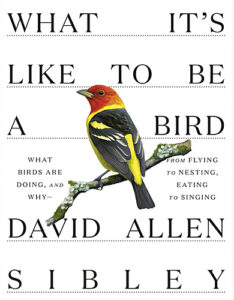Volume 26 Issue 2, Spring 2021
Review by Joe Coleman
 Birds have fascinated humankind for millennia. Their variety, their ability to fly, their intriguing behavior, and the fact that they surround us draws our attention and raises questions in our minds. Why doesn’t a woodpecker get a concussion from constantly pounding its beak against a tree trunk? How do vultures find their food, by smell or sight? How do the bird species that cache thousands of nuts in hidden locations find them later? The answers to these and many other questions can be found in David Sibley’s What It’s Like to Be a Bird, a popularly-written, well-illustrated, large-format book.
Birds have fascinated humankind for millennia. Their variety, their ability to fly, their intriguing behavior, and the fact that they surround us draws our attention and raises questions in our minds. Why doesn’t a woodpecker get a concussion from constantly pounding its beak against a tree trunk? How do vultures find their food, by smell or sight? How do the bird species that cache thousands of nuts in hidden locations find them later? The answers to these and many other questions can be found in David Sibley’s What It’s Like to Be a Bird, a popularly-written, well-illustrated, large-format book.
While Sibley is the author and illustrator of The Sibley Guide to Birds and a winner of the American Birding Association’s Roger Tory Peterson Award for lifetime achievement in promoting the cause of birding, this book’s focus is on familiar backyard birds — blue jays, nuthatches, and chickadees, and also includes species that are fairly easily observed, including a variety of hawks, vultures, and owls.
In his preface Sibley describes what he has learned during a lifetime of writing about and illustrating birds, writing “that a bird’s experience is far richer, more complex, and more ‘thoughtful’ than I’d imagined. And if that is news to me after a lifetime of watching birds, it must be surprising to other people as well.”
While the idea for this book began 15 years ago as a bird guide for children, he decided to make it a broader introduction to birds but to keep it accessible to all ages and to answer those questions that pop into our minds when we watch different kinds of birds. He has succeeded in putting together a beautifully illustrated book that is a wonderful introduction to the world of birds, what they are, and why and what they do. Its illustrations and its descriptions of the various kinds of birds not only convey the beauty and wonder of birds, but are wonderful aids in sharing what makes birds both so diverse and so special. For example, in his section on the corvids — which includes crows, ravens, and jays, all species that have fascinated me — he succinctly describes their intelligence, their social abilities, and how they fit into the environment.
The introduction describes aspects of bird behavior and physiology, such as feathers, coloration, bird senses, and intelligence, and is followed by sections on the different families, including specific information describing interesting attributes for each species.
We were taught that it isn’t scientific to anthropomorphize animals, including birds, and that they weren’t intelligent, that they didn’t have feelings like we do and that they are capable of only the most rudimentary learning. Fortunately, this attitude is changing. David Sibley’s What It’s Like to Be a Bird offers many valuable insights about birds.

